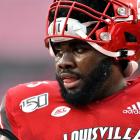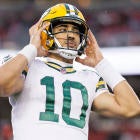The New York Jets did something unusual around this time last year when they fired general manager Mike Maccagnan and hired Joe Douglas after they had already completed the 2019 NFL Draft. A few months later when Maccagnan's final third-round pick Jachai Polite was released prior to Week 1, this decision was immediately justified, but it had been long overdue before that. Maccagnan's tenure was filled with failed draft picks, free agent busts, and a whole lot of salary cap space he decided to never use. The one thing Maccagnan left the Jets was prospective franchise quarterback Sam Darnold, but it almost felt like he did everything in his power not to build the right way around him. Enter Douglas.
After taking over as Jets general manager, Douglas made it clear that he believed in building around Darnold the right way -- and in his mind that starts with prioritizing his protection over the skill players around Darnold. Instead of forcing things in a free agent class that was underwhelming at all three positions on the offensive line, Douglas patiently bided his time knowing the 2020 NFL Draft class was as loaded with offensive tackle talent as it's been in at least the last decade. A case can be made the Jets need help on the interior of the offensive line, too, but no position needed an influx of talent more than offensive tackle.
So Douglas kept things simple. He stuck around at No. 11 overall and selected one of the four blue-chip offensive tackles. I would argue no one has more upside in this class than Mekhi Becton. While he hasn't been tested as much as his peers in pass protection, and there are some technical flaws in his game, we've seen players of his size, length, and athleticism overcome these issues simply because pass rushers can't get around them (see: Byrant McKinnie, Orlando Brown Jr.). And anyone who spends the pre-draft process working with offensive line guru Duke Manyweather stands out to me.
It was everything Douglas did after the Becton pick that was most impressive. By trading back from No. 48 overall for No. 59 and No. 101, he added another Day 2 pick. Douglas' shrewd decision paid immediate dividends when he selected a player from the same position at No. 59 overall in wide receiver Denzel Mims. And it's certainly possible Mims would have been the pick at 48. Douglas then leveraged the No. 101 pick to acquire No. 125, No. 129 and a 2021 sixth-round pick. This allowed the Jets to acquire more developmental prospects.
The 2020 draft is in the books and that means it's time for grades. Will Brinson and the Pick Six Podcast Superfriends grade how all 16 AFC teams did; listen below and be sure to subscribe for daily NFL goodness.
After the dust had settled, the Jets filled their two greatest needs (offensive tackle, wide receiver) by drafting into the strength of this class with their first two picks, they drafted a safety with a unicorn trait (the best range in the deep half in the entire class), they drafted toolsy and twitchy EDGE prospect (a nice break from the Jordan Jenkins types), a developmental quarterback to back up Darnold, and arguably the most intriguing developmental offensive tackle prospect (Cameron Clark) to come off the board on Day 3. As if that wasn't enough, they also drafted a cornerback (Bryce Hall) who was in the first-round conversation prior to an injury-plagued 2019 season. If that's not an "A" graded draft then I'm good throwing out all draft grades from this point on.
A couple of weeks before the draft, I outlined what I thought would be a perfect four-step plan for the Jets to follow in the draft and they nailed nearly every step. Of course, the Jets entered this draft with a lot of needs and there is an argument to be made that Douglas deployed a boom-or-bust strategy overall. After examining what the Jets did well, we'll look deeper into what they didn't accomplish in the draft, what roster needs remain, and what it might mean moving forward for the rest of the offseason.
1. It wasn't a very risk-averse class
The Jets draft has been labeled by some as a boom-or-bust class and it's hard to argue with that. Becton is the only tackle in this class I see with legitimate Hall of Fame upside, but he also has the best chance of being a total liability (I don't see it happening, but there is a path for someone as untested in pass protection). Mims has the frame and testing times you would use to create a wide receiver in a lab, but can he get off press-coverage at the NFL level? We sure didn't see much of that in the Big 12. Ashtyn Davis has the kind of elite range in deep coverage that maybe two handfuls but more likely one handful of NFL safeties currently possess, and that trait can transform an entire defensive system depending on the coordinator, but he also has obvious red flags on the injury front that likely led to his slide. Zuniga is a toolsy EDGE prospect with limited production at Florida and it's hard to figure out what led to that.
Going risk-averse is not the right way to draft by any means, but an argument can be made they should have incorporated it in this class to some degree. Douglas is betting on his evaluation skills, and personally, I think he found excellent value with each of his first four picks.
2. Are we sure the Jets can hold up in coverage?
The Jets entered this draft with one of the weakest and shallowest cornerback depth charts in the NFL. They didn't do much to address that concern in the draft. It's true Bryce Hall was considered a potential Day 1 prospect one calendar year ago, but there's a reason he fell into Round 5, and the injury concern is there. Outside of Hall, the Jets are counting on Colts retread Pierre Dessir, Arthur Maulet, Brian Poole, and Blessuan Austin to hold the fort down when opposing offenses use three wide receiver sets -- the vast majority of all snaps. That's quite the projection. And if injuries strike?
It's possible the Jets may consider converting Davis back to cornerback where he started his career at Cal, but that would be wasting his best trait (his range in the deep half). The Jets still have a lot of work to do on the back end.
3. They failed to double-dip at WR
In a potentially historic wide receiver class, it was vital for the Jets to come away with at least one prospect at this position. As a firm believer of the "draft into the strength of the class" strategy, the Jets should have really come away with two prospects at wide receiver. Although I wouldn't have selected any wide receiver over Davis and Zuniga, I would have targeted a Day 3 wide receiver like fifth-round pick Quintez Cephus -- a nice compliment to Mims. Entering the draft, the Jets wide receiver depth chart was arguably the NFL's worst aside from the Eagles. Breshad Perriman, Jamison Crowder, and the oft-injured Quincy Enunwa are not enough. Adding Mims should help, but they would have benefited from taking another swing at the deepest and most talented position in this draft class.

















